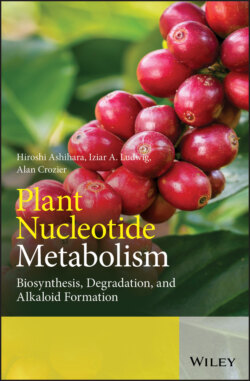Читать книгу Plant Nucleotide Metabolism - Hiroshi Ashihara - Страница 59
4.2.6 Synthesis of Aminoimidazole Carboxylate Ribonucleotide
ОглавлениеIn contrast to animals, plants carboxylate AIR to 4-carboxy aminoimidazole ribonucleotide (CAIR) in a two-step reaction catalysed by aminoimidazole ribonucleotide carboxylase (AIRC, EC 4.1.1.21) (step 6, Figure 4.1, Reaction 6).
This two-step reaction in plants is similar to that occurring in E. coli, where two separate enzymes, 5-(carboxyamino)imidazole ribonucleotide (N5-CAIR) synthase (PurK, EC 6.3.4.18), and N5-CAIR mutase (PurE, EC 5.4.99.18) are required to carry out the single reaction catalysed by AIRC (EC 4.1.1.21) in eukaryotes. In plants and yeast, PurK, and PurE proteins are fused and form an enzyme complex (Voet and Voet 2010). As in yeast, the moth bean (Vigna aconitifolia) AIRC has an N-terminal domain homologous to the bacterial purK gene product. This purK-like domain appears to facilitate the binding of HCO3− and is dispensable in the presence of high HCO3− concentrations (Chapman et al. 1994).
In animals, activities of AIRC and the enzyme catalysing the next step, 4-(N-succinocarboxamide)-5-aminoimidazole synthetase (SAICARS), are associated with a single bifunctional polypeptide. However, these two enzymes are distinct proteins in plants (Chapman et al. 1994).
